- Skip to primary navigation
- Skip to main content
- Skip to primary sidebar

- FREE Experiments
- Kitchen Science
- Climate Change
- Egg Experiments
- Fairy Tale Science
- Edible Science
- Human Health
- Inspirational Women
- Forces and Motion
- Science Fair Projects
- STEM Challenges
- Science Sparks Books
- Contact Science Sparks
- Science Resources for Home and School

Parachute Egg Drop Experiment – Gravity and Air Resistance
July 19, 2019 By Emma Vanstone 9 Comments
This fun parachute egg drop experiment is a great demonstration of the forces acting on parachutes. If you drop something, it falls to the ground. This is because it is pulled by the gravity of the Earth. You’ll notice that some things drop faster than others. This is because of air resistance . Try dropping a piece of paper and a lego brick. Which drops the fastest?
We are going to try dropping an egg on its own, dropping an egg attached to a parachute and an egg in a basket under a balloon.
Egg Drop Experiment
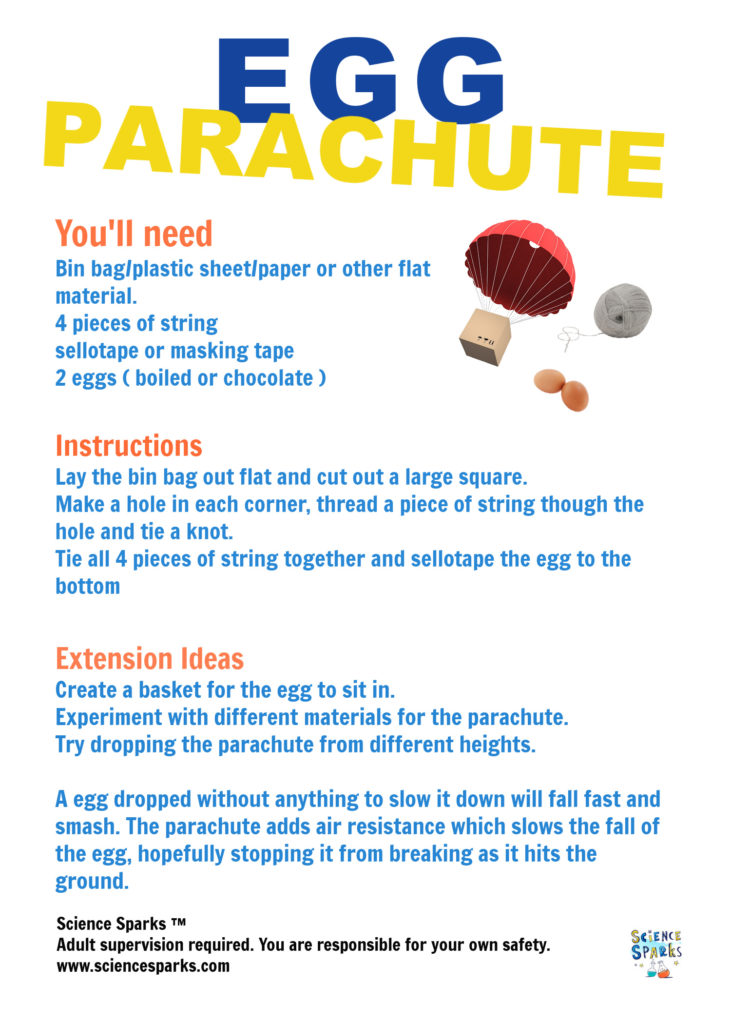
How to make an egg parachute
What you need to make a parachute.
- Bin bag/ plastic sheet/paper or other flat material.
- 4 pieces of string
- sellotape or masking tape
- 3 eggs ( we boiled ours )
Parachute Instructions
- Lay the bin bag out flat and cut out a big square.
- Make a hole in each corner, thread a piece of string through it and tie a knot.
- Tie all 4 pieces of string together and sellotape the egg to the bottom
Make Your Own Air Balloon
Air balloon materials.
- Cardboard made into a basket shape or a small plastic container
- Balloon blown up
- 4 pieces of String
Air Balloon Instructions
- Sellotape some string to your balloon and attach the basket.
- Place the egg in the basket
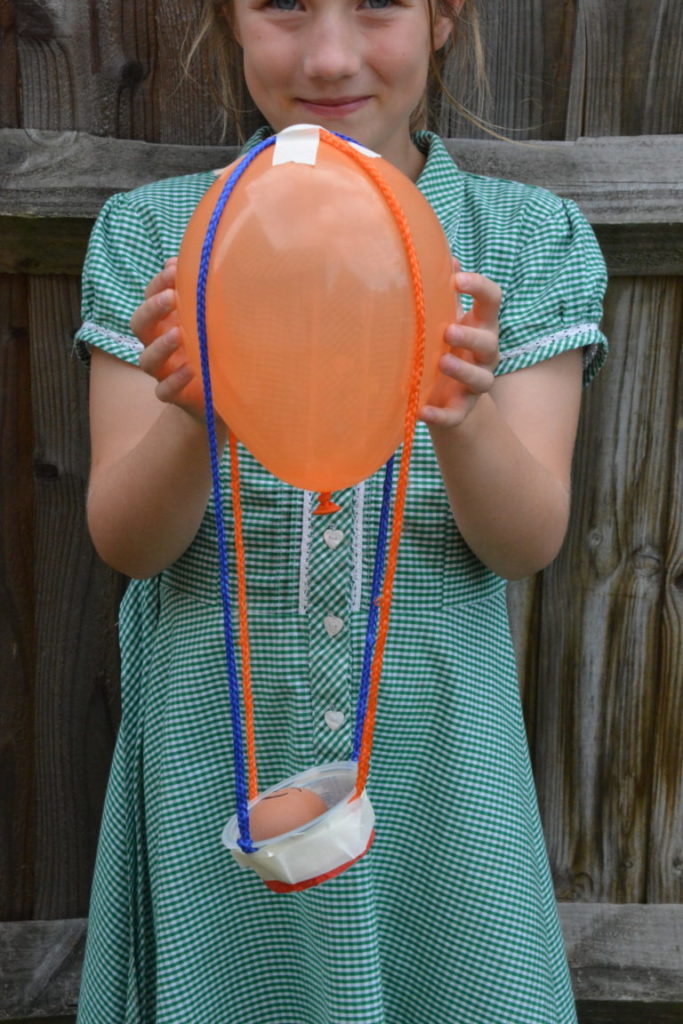
Drop an egg on its own, the egg in the basket and the egg in the parachute from somewhere high up. Make sure an adult is around to help with this part.
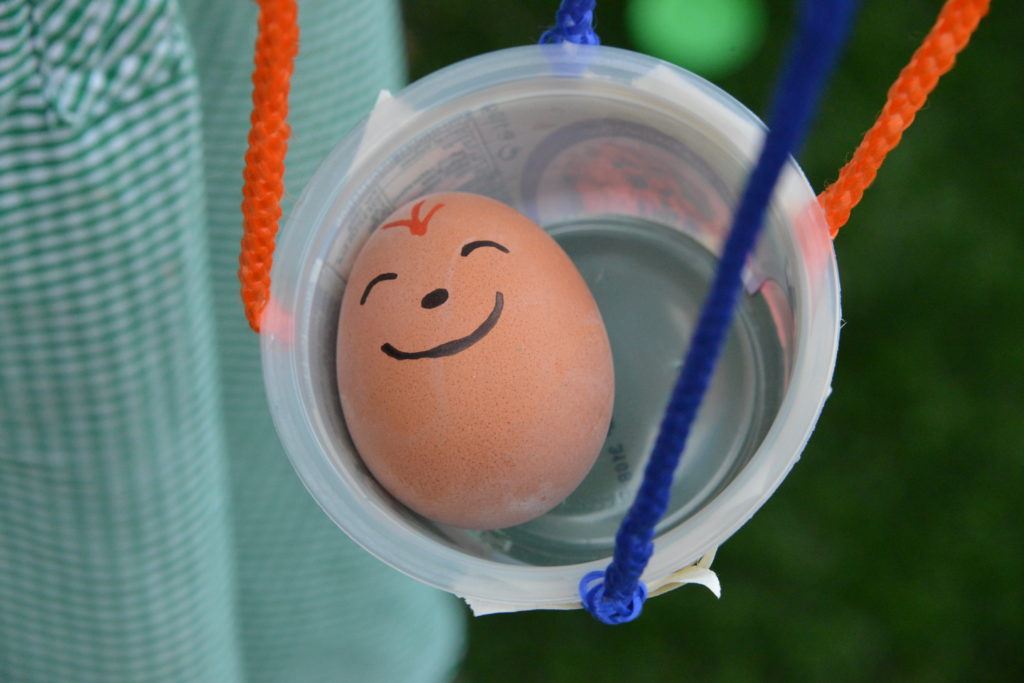
Gravity and Air Resistance Explained
If you tried dropping paper and a lego brick or similar, the paper should have dropped to the floor more slowly than the brick. This is because the paper has a larger surface area, so has to push against more air as it drops, which means the air resistance is greater, and it drops more slowly.
An egg dropped without anything to slow it down will fall fast and break; the parachute and balloon add air resistance, slowing the fall and stopping the egg from breaking.
We also found that the parachute fell much more slowly than the balloon. This is because the parachute has a larger surface area than the balloon, and so slows the descent of the egg more.
If we dropped a hammer and a feather, we would expect the hammer to fall fastest; however, if we did this on the moon where there is no air resistance, they would hit the ground at the same time!
How do Parachutes Work?
As we explained above, two forces act on an object as it falls. Gravity pulls the object down, and air resistance slows the fall.
Parachutes are used to slow the fall of an object by increasing air resistance which reduces the effect of gravity!
More parachute investigation Ideas
Record the time taken for all three to drop and see how much slower the parachute is.
Try our experiments you can make fly .
Experiment with different sizes of parachutes and see which drops more slowly.
Don’t forget to try our collection of easy ideas for learning about forces too.
In This IS Rocket Science we made parachutes with coffee filters which was great fun and you can experiment with different sizes and shapes.
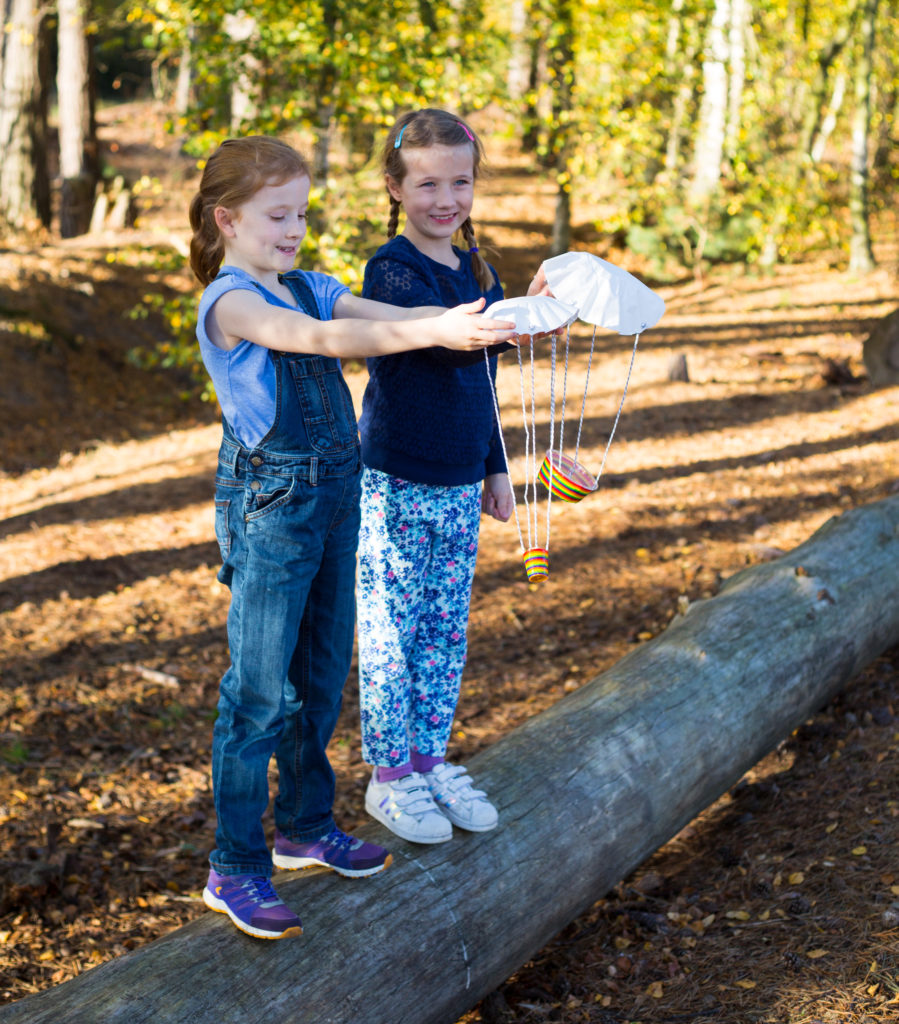
If you liked this science experiment you’ll LOVE my book This IS Rocket Science, which has 70 space themed science experiments for kids!
This post was originally published in 2011 and updated July 2019
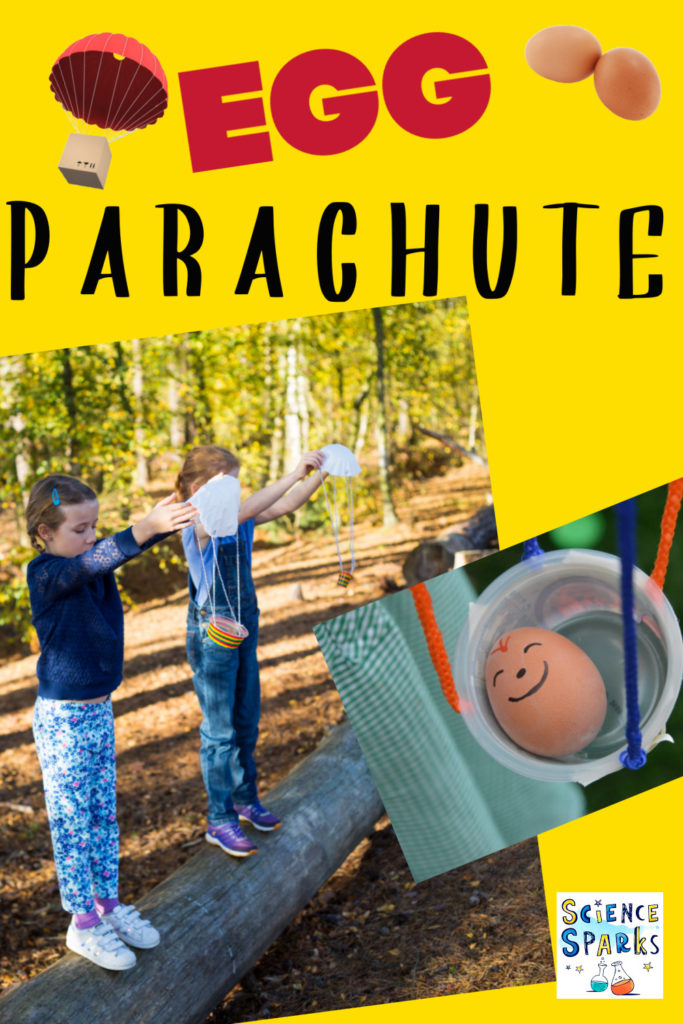
Last Updated on March 14, 2023 by Emma Vanstone
Safety Notice
Science Sparks ( Wild Sparks Enterprises Ltd ) are not liable for the actions of activity of any person who uses the information in this resource or in any of the suggested further resources. Science Sparks assume no liability with regard to injuries or damage to property that may occur as a result of using the information and carrying out the practical activities contained in this resource or in any of the suggested further resources.
These activities are designed to be carried out by children working with a parent, guardian or other appropriate adult. The adult involved is fully responsible for ensuring that the activities are carried out safely.
Reader Interactions
September 11, 2011 at 8:49 am
Fab. Really well explained!
September 14, 2011 at 10:11 pm
Thank you. xx
October 28, 2013 at 12:44 am
cool video but it didn’t answer my question
September 11, 2011 at 3:03 pm
You always make science fun!
September 14, 2011 at 10:10 pm
Thank you, we do try!
September 11, 2011 at 7:59 pm
That is cool. Did the egg break when you did that? Nevermind I saw the answer when I reread it.
THanks for linking up this week!
Thank you for hosting such a great link up. x
September 14, 2011 at 2:16 pm
Love how you make science fun and bring it into the home… Did you know I did Physics A-Levels? Well, this will come in handy with my kids! 🙂
Thanks for sharing on Kids Get Crafty!
June 10, 2016 at 9:08 am
This website is very good in my school all the year 5 used it to make a paacute for there topic ‘Wacky races’ thank you for making it
Leave a Reply Cancel reply
Your email address will not be published. Required fields are marked *

27 Fun & Creative Egg Drop Challenge Ideas
The egg drop challenge is more than just a quirky science experiment; it’s a masterclass in problem-solving, creative engineering, and learning how to embrace failure as a crucial step to success.
In the egg drop challenge, your aim is to design a device that will protect a raw egg from breaking when dropped from a significant height.
Students learn that the most brilliant solutions often emerge from unexpected combinations of unconventional materials and that failure is simply an opportunity to learn and improve.
We’ve curated egg drop challenge ideas that go far beyond the traditional “drop from a ladder” approach. Each challenge is carefully crafted to teach fundamental principles of physics, structural design, and creative problem-solving while keeping the experience fun, collaborative, and memorable.
Egg-Cellent Ideas!
1. humpty dumpty science.

Humpty Dumpty Science is a fun and educational activity that helps kids explore the wonders of gravity and physics! This hands-on experiment uses a simple egg in a ziplock bag, with a drawn face, to mimic the classic Humpty Dumpty tale.
Accompanied by a printable worksheet, kids can predict, test, and observe what happens when Humpty “falls” just like in the nursery rhyme.
Learn more: I Heart Crafty Things
2. Pool Noodle Egg Drop
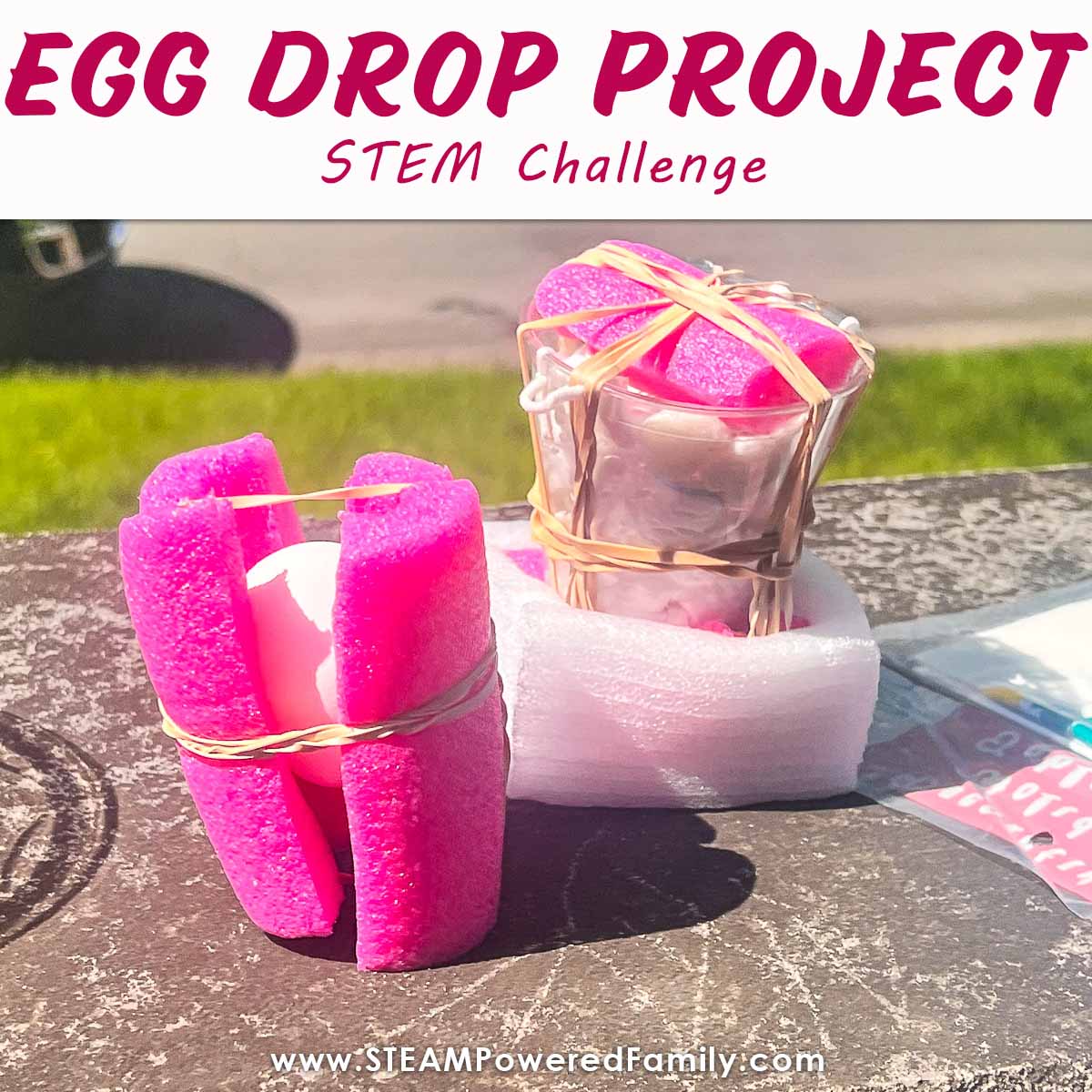
The Pool Noodle Egg Drop experiment is an exciting and creative way to challenge kids to think about the principles of engineering and physics!
Using a simple pool noodle as the main structure, the goal is to design a contraption that can safely protect an egg from cracking during a drop.
Learn more: Steam Powered Family
3. Sponge Egg Drop

The Sponge Egg Drop experiment is a fantastic way to introduce kids to the concepts of force, cushioning, and gravity in a fun, hands-on activity!
Using sponges as the primary material, the challenge is to create a protective case around an egg that will absorb the shock of a drop and prevent it from cracking.
Learn more: Green Kids Craft
4. Paper-Straws Egg Drop
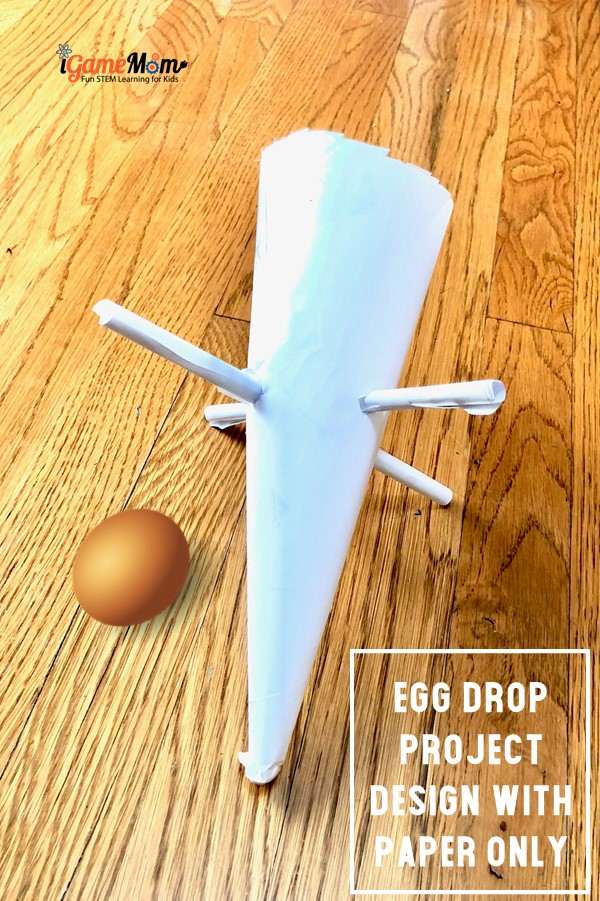
The Paper-Straws and Paper Cone Egg Drop is an exciting and innovative challenge that encourages kids to think like engineers! Using only paper straws and a paper cone, the task is to design a structure that can protect an egg from breaking when dropped from a height.
Learn more: I-Game Mom
5. Ship Egg Drop

In this activity, kids must design packaging using everyday materials to protect an egg during a drop, much like how companies protect delicate items during shipping. This hands-on project encourages children to think critically about impact, cushioning, and safety while experimenting with different packaging techniques.
Learn more: Cool Science Dad
6. Oobleck Egg Drop

The Oobleck Egg Drop is an exciting experiment that combines science with sensory play! Using the non-Newtonian fluid known as Oobleck (a mixture of cornstarch and water), kids must explore whether this gooey substance can protect an egg from breaking during a drop.
7. Dodecahedron Egg Drop
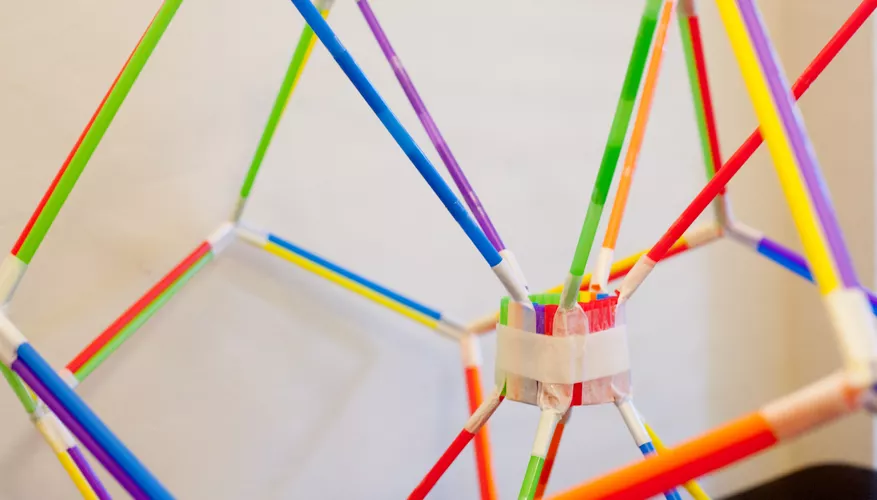
The Dodecahedron Egg Drop is a creative and geometric twist on the classic egg drop challenge! In this activity, kids will design and construct a protective case for an egg using the shape of a dodecahedron a 12-sided polygon.
Learn more: Sciencing
8. Tissue Paper Egg Drop
The Tissue Paper Egg Drop is a light and delicate twist on the classic egg drop experiment! Using only tissue paper as the primary material, kids must find creative ways to protect an egg from cracking when dropped from a height.
9. Reinforcement Egg Drop

The Reinforcement Egg Drop adds an exciting engineering twist to the traditional egg drop challenge by incorporating support structures inside a box! Using bottles and elastics or garters as reinforcements, the task is to design a protective system that shields the egg from impact during a drop.
Learn more: Living Digitally
10. Bottle-Pantyhose Egg Shield

The Plastic Bottle-Pantyhose Egg Shield is a unique and creative spin on the classic egg drop challenge! In this experiment, kids must craft a protective shield for an egg using a plastic bottle and pantyhose.
Learn more: Kiwi Co
11. Paper Egg Drop

The Paper Egg Drop is a fun and educational experiment that challenges kids to protect an egg using only paper as the cushioning material.
In this activity, children must design and construct a protective enclosure out of paper to shield the egg from breaking when dropped from a height.
Learn more: I Game Mom
12. Crash Car Egg Drop
The Crash Car Egg Drop is an exhilarating experiment that combines the thrill of building and testing with the science of impact and protection! In this challenge, kids design and construct a mini crash car with the mission of keeping an egg safe during a collision or drop.
13. The Egg Slip

In this activity, an egg is placed on top of a toilet paper roll that is balanced on a flat surface, like a table. The challenge is to quickly slide the cardboard out from under the egg, allowing it to fall straight into a glass with water below due to inertia.
This experiment demonstrates how objects at rest tend to stay at rest unless acted upon by an external force.
Learn more: The Dad Lab
14. Egg Drop Inertia

In this activity, the goal is to balance a plastic egg on top of an object, such as a toilet paper roll or a cup, and then quickly remove the base, allowing the egg to drop straight down into a container below.
Learn more: Rookie Parenting
15. Popsicle Stick Fortress

The Popsicle Stick Fortress is an engaging and creative experiment where kids build a protective fortress for an egg using popsicle sticks and elastics. The challenge is to construct a sturdy structure that can safely cushion the egg during a drop.
Learn more: Feel Good Teaching

16. Balloon Egg Drop

The Balloon Egg Drop is a delightful and inventive experiment that combines the fun of balloons with the challenge of protecting an egg! In this activity, kids use balloons as the primary cushioning material to create a protective barrier around an egg.
Learn more: The Caffeinated Homeschool Ista
17. Egg Bungee

The Egg Bungee is an exciting and inventive experiment that explores the concepts of elasticity and gravity in a hands-on way!
In this activity, kids create a bungee cord for an egg using elastic bands or string, and then design a setup where the egg is suspended and safely lowered from a height.
Learn more: MSI Chicago
18. Space Helmet Egg Drop

The Space Helmet Egg Drop is an imaginative and educational experiment where kids create a “space helmet” to protect an egg as it undergoes a simulated space landing! Using materials like cardboard, foam, and tape, children design a helmet that shields the egg from impact during a drop.
Learn more: Raising Arizona Kids
19. Cardboard Lander

The Cardboard Lander is an innovative and hands-on experiment where kids design a protective landing system for an egg using cardboard and elastics.
In this activity, the egg is placed inside a cardboard container that is secured with elastics, creating a shock-absorbing mechanism to cushion the egg during a drop.
Learn more: Learn Ada Fruit
20. 2-Layered Toilet Paper Tube Egg Drop

The 2-Layered Toilet Paper Tube Egg Drop is a simple yet effective experiment where kids design a protective casing for an egg using two layers of toilet paper tubes. The challenge is to place the egg inside the glass with water.
Learn more: Just A Mums
21. Oobleck Egg Drop

In this activity, the egg is placed inside a Ziplock bag filled with Oobleck. When the bag is dropped, the Oobleck acts as both a solid and a liquid, depending on the force of impact, helping to cushion and protect the egg.
Learn more: Mad About Science
22. Marshmallow Cup Egg Drop

The Marshmallow Cup Egg Drop is a fun and squishy twist on the classic egg drop challenge! In this experiment, kids use marshmallows as the cushioning material inside a cup to protect an egg from breaking during a drop.
Learn more: 123 Homeschool 4me
Parachute Drop
23. mission: safe landing.
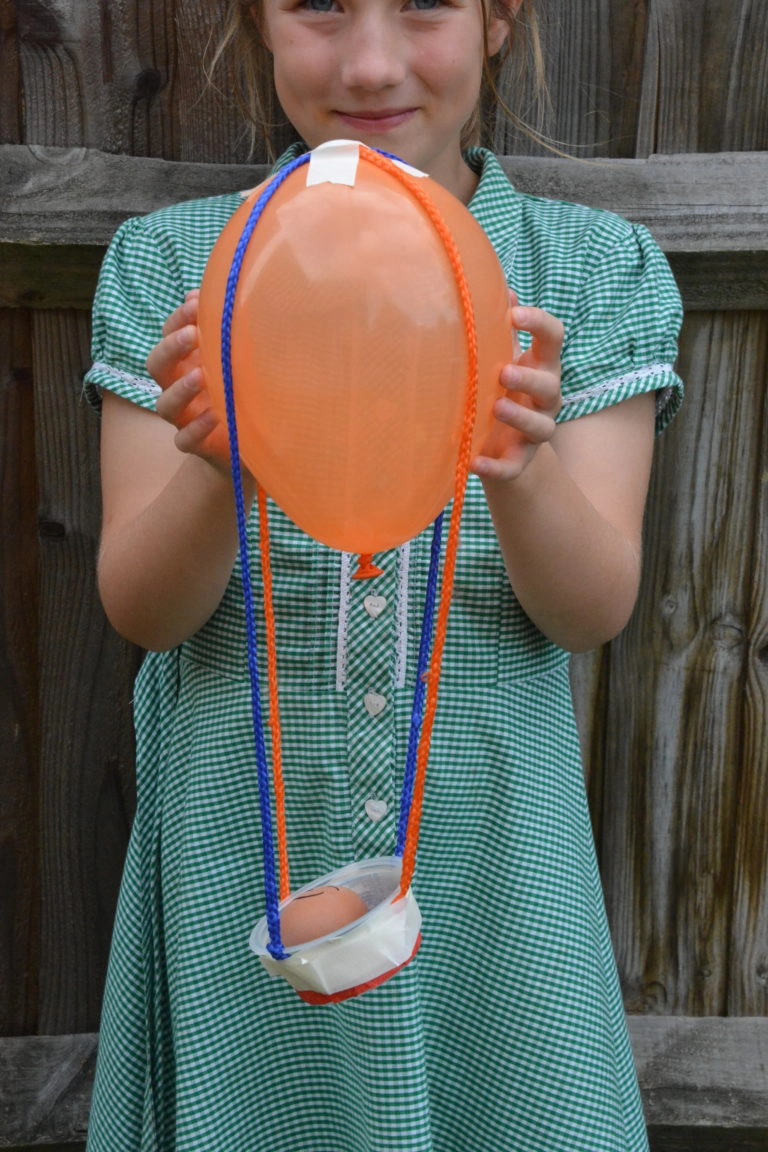
Mission: Safe Landing! is an exciting challenge that combines engineering and creativity to protect an egg during a drop using only a balloon and a cup. In this experiment, kids attach a balloon to a cup containing the egg, creating a mini landing craft designed to slow the fall and absorb impact.
Learn more: Science Sparks
24. Eggs in Flight

This egg drop takes the classic egg drop challenge to new heights by incorporating a parachute along with a toilet paper roll to protect the egg. In this experiment, the egg is covered with a toilet paper roll and attached to a parachute, which is designed to slow its descent.
Learn more: Buggy And Buddy
25. Coffee Filter Parachutes

The coffee filters act as parachutes, increasing air resistance and slowing the egg’s descent. The challenge is to attach the coffee filters to the egg in such a way that it floats softly to the ground without breaking.
Learn more: J Daniel’s 4s Mom
26. Operation Egg Drop
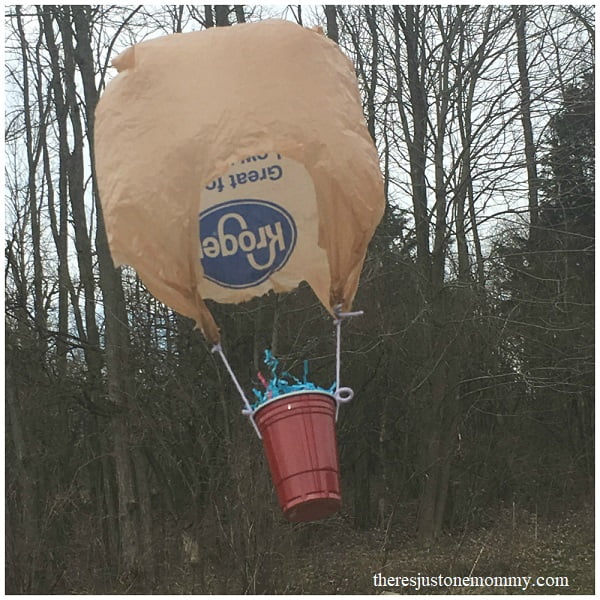
Operation Egg Drop is an exciting challenge where kids combine creativity and engineering to safely land an egg using a plastic parachute, a cup, and a few clever design choices. In this experiment, the egg is placed inside a cup that is securely attached to a plastic parachute.
Learn more: There’s Just One Mommy
27. Common Craft Egg Drop

In this project, the egg is carefully wrapped in plastic and surrounded by inflated balloons, which act as a cushion to absorb impact and prevent the egg from cracking. The balloons help disperse the force of the drop, while the plastic offers additional protection.
Learn more: Feels Like Home Blog
Similar Posts:
- Top 100 Fine Motor Skills Activities for Toddlers and Preschoolers
- Top 58 Creative Art Activities for Kids and Preschoolers
- Top 45 Fun Name Activities for Preschool and Kindergarten
Leave a Comment Cancel reply
Save my name and email in this browser for the next time I comment.
How To Make An Egg Drop Experiment With A Parachute

Learning how to create a parachute to safely drop an egg can spark a student's interest in physical forces like gravity and air resistance. Air resistance is basically friction with gas particles, which can slow down the speed of a falling object. Parachutes work on this idea, and this experiment is designed to show how air resistance can be used to safely drop an egg from 10 ft. or higher. Many aspects of this project can be changed for variables, but the main one is the size of the parachute. Determine whether larger parachutes work more efficiently than smaller ones.
Cut three squares out of plastic trash bags. Each square should be cut with different dimensions to test whether larger parachutes are more effective. Cut one square so it is 10 inches square, one so it is 20 inches square and the final one 30 inches square. Use a ruler to ensure that these measurements are precise. Cut the squares using scissors.
Tie a piece of string around the corners of the three squares. Tie the knot as close to the end of the string as possible. Put a small piece of Scotch tape on the corners of each square. This helps to strengthen the link between the plastic and the string, making it easier to create a working parachute. You will then be left with three parachutes that have four pieces of string dangling from each, held in place by tape and the original knot.
Tie the other ends of the string to the two corners of a sandwich bag near the opening. Tie two pieces of string to each corner. Reinforce the connections with Scotch tape in the same way as before. Do this on each of the three parachutes, so you have a large bin liner square attached to a sandwich bag with string. The sandwich bag will hold your egg.
Put an egg in each sandwich bag, and find a suitable location to drop the parachute. Drop the parachutes from at least 10 ft high to get the best result. Predict which parachute will work best. Understand that gravity will pull the parachute down to the ground, but the large surface of the plastic bags will create more air resistance. This eventually leads to the parachutes hitting terminal speed, where the air resistance counteracts the gravity and the egg drifts safely to the ground.
Determine which parachute was more effective. Discount any egg that breaks on impact with the ground. Watch to see which parachute catches the air and reaches terminal speed first. Watch for the change between falling and gliding to see this.
Things Needed
- Plastic kitchen bin liners
- 3 sandwich bags
- 12 20-inch pieces of string
- Scotch tape
- Discovery Education; Forces and Motion; Ted Latham
- Houghton Mifflin's: Project 3: The Egg-Drop Experiment
- Aero: Making the Parachute
Cite This Article
Johnson, Lee. "How To Make An Egg Drop Experiment With A Parachute" sciencing.com , https://www.sciencing.com/make-egg-drop-experiment-parachute-12064516/. 24 April 2017.
Johnson, Lee. (2017, April 24). How To Make An Egg Drop Experiment With A Parachute. sciencing.com . Retrieved from https://www.sciencing.com/make-egg-drop-experiment-parachute-12064516/
Johnson, Lee. How To Make An Egg Drop Experiment With A Parachute last modified March 24, 2022. https://www.sciencing.com/make-egg-drop-experiment-parachute-12064516/
Recommended
- Youth & Family
- Youth & Family Learning Activities
Egg Parachute
Have you ever thrown an egg up into the air? Chances are it will come back down and make a big mess. In this activity, kids will learn how to harness the power of physics and air resistance to make an egg parachute.
Activity Supplies
Pantry staples.
- 3-, 7-, or 9-ounce plastic or foam cups
- 9 facial tissues
- 1 plastic garbage bag
- String (lightweight)
- Masking tape
- Measuring tape or yard stick
Specialty Supplies
Activity steps.
- Prepare the egg cradle. Use a hole punch to make four holes in the top of each cup.
- Take a few tissues and wad them up before putting them in the bottom of each cup.
- Now make three different parachutes to test. Take the plastic garbage bag and cut a small, medium and large size square. The recommended sizes are: 10” x 10”, 20” x 20”, and 30” x 30” but allow kids to experiment with the sizes!
- For each parachute cut four equal lengths of string (you will need 12 total). Tie apiece of string to each corner of the plastic garbage bag square, then attach the four loose ends of the strings to each cup, matching the parachute corners to the same corner on the cup.
- Mark each cup with an A (10” x 10”), B (20” x 20”), and C (30” x 30”) to keep track of how the different parachutes perform.
- Place one egg in each cup, on top of the balled-up tissues, using masking tape to keep the egg in place. Then add a few more crumpled tissues and put masking tape across the top of each cup.
- Predict which egg has the best chance of surviving a fall from 10–12 feet.
- Test each parachute by dropping it (unfurled) as you hold it from the top center of the parachute. Time each flight and record your results. Note: If any eggs break on the landing, encourage kids to make changes to the design to prevent any breaks the next time they try.
WVU is an EEO/Affirmative Action Employer -- Minority/Female/Disability/Veteran. In accordance with Federal law and U.S. Department of Agriculture (USDA) civil rights regulations and policies, this institution is prohibited from discriminating on the basis of race, color, national origin, sex, age, disability, and reprisal or retaliation for prior civil rights activity. (Not all prohibited bases apply to all programs). The WVU Board of Governors is the governing body of WVU. The Higher Education Policy Commission in West Virginia is responsible for developing, establishing, and overseeing the implementation of a public policy agenda for the state’s four-year colleges and universities. Reasonable accommodations will be made to provide this content in alternate formats upon request. Contact the WVU Extension Service Office of Communications at 304-293-4222.
An Egg Drop Parachute Makes For An Eggsellent Experiment

Struggling to come up with new and exciting ways to teach your kids science , or simply looking for a cool experiment to conduct at home?
Why not carry out your very own Egg Drop Challenge? Not only is this super easy to do and so much fun to carry out, but it only requires a few basic materials that you'll already have in your cupboard.
Not to mention, the whole family will enjoy the mission of creating a parachute that can safely deliver an egg to the ground (and learning about the science behind it)!
Aim Of The Experiment
To understand how gravity and forces act on a falling object, how the surface area of a given object affects air resistance, and to learn how to build a parachute.
Materials Needed
Plastic bags or bin bags , scissors , string , plastic sandwich bags or plastic cups , and eggs.
1) Start off by asking the kids for their predictions. Will the egg land safely, or fall quickly and crack? How long do they think it will take to reach the ground? Note these down - we'll explain the science behind it later.
2) Cut out a large square from your plastic/bin bags, of at least 25cm on each side.
3) Cut four pieces of string, and make sure that they're of equal length both to each other and to the side of your square - 25cm each.
4) Poke each of the four corners of your square with the scissors to create a small hole, then thread a string through each one and knot them to ensure that they stay firmly in place.
5) Place an egg into a sandwich bag or plastic cup and tie/wrap it shut.
6) Tie the ends of each of the strings around the top of the sandwich bag (this will keep the bag closed), or poke holes into your plastic cup with a knife and thread and knot the string through.
7) Go to an upstairs window and with the help of a parent, lift the parachute with two fingers from the middle of the plastic square and release - letting it float to the ground.
How to Record Results
Image © Science Sparks
You can observe your egg drop science experiment and record results in various ways by repeating the experiment with different lengths of string and different sized parachutes - both bigger and smaller.
Using a timer for each drop to see how long the egg took to reach the ground and noting these down is a great way to see how different surface areas affect speed and gravity, and noting down whether or not the egg landed safely or broke in the process is also helpful.
When you've finished recording all of your results, you'll be able to see whether or not your initial predictions were correct. Make sure the kids have their notes ready at the end of the experiment so you can get explaining the science!
The Science Behind the Results
The results of this exciting eggsperiment all come down to a simple explanation - gravity and air resistance. It's important to explain to your kids that when an objecting is falling, there are two forces acting on it.
Gravity will always pull an object towards the ground, whereas air resistance will come into play in the opposite direction to slow it down.
Ask your kids if they've noticed that certain objects fall much faster than others - for example, a piece of paper and a small toy. A piece of paper is always going to fall much more slowly than a toy, and this is because it has a much larger surface area for air resistance to react against.
Give it a go, and see for yourself!
So, what stopped the egg from crashing down into the ground in your experiment?
If you were to drop an egg from a second-story window all by itself, it would quickly fall straight to the ground and crack open - leaving you an eggy mess.
However, when you drop an egg with a parachute, as you've just done in this experiment, the strings and the egg-filled sandwich bag being pulled down by gravity causing the plastic/bin bag to open up, creating a large surface area that will increase the air resistance and therefore slow the fall, reducing the natural effect of gravity.
In terms of the various different results that the kids recorded, you should find that the larger the square of the plastic bag that you used for your parachute, the slower it fell, and the less harm that came to the egg.
Smaller parachutes will have fallen faster due to the reduced surface area and air resistance, and may have even resulted in a cracked egg!
Alternative Experiments to Try
If you're looking for similar experiments to try out at home, why not attempt one of the following?
1) Repeat the egg parachute drop project, but this time use different materials for the parachute such as a large sheet of paper, a balloon, or even an entire plastic bag. Don't forget to make your predictions beforehand and record your results!
2) Repeat the parachute drop but this time do it using different objects, such as toys or small teddy bears. Will the parachute still work as effectively on heavier objects?
How will the weight change the effects of gravity and air resistance? Will two objects of different weights reach the ground at the same time? Let the kids take notes and use this to further explain the science behind it.
We Want Your Photos!
More for you, 13 super easy activities for kids at home with no equipment, fun things to do this easter at home with kids, fresh family ideas for spring activities.
Bachelor of Arts specializing in Journalism
Rachel Garner Bachelor of Arts specializing in Journalism
Growing up in Switzerland, Rachel developed a love for exploring new places and trying new foods. She has a Bachelor's degree in Journalism from the University of the Arts London. She currently resides in Northwest London and enjoys discovering trendy spots around the city. Rachel is also passionate about planning fun activities for her family, particularly her little cousins. When she has some downtime, she can be found indulging in hobbies such as attending concerts, baking, or visiting her family in Essex. Her love for travel takes her beyond the UK, where she meticulously plans and researches each adventure before setting off to explore new places across Europe and beyond.
1) Kidadl is independent and to make our service free to you the reader we are supported by advertising. We hope you love our recommendations for products and services! What we suggest is selected independently by the Kidadl team. If you purchase using the Buy Now button we may earn a small commission. This does not influence our choices. Prices are correct and items are available at the time the article was published but we cannot guarantee that on the time of reading. Please note that Kidadl is a participant in the Amazon Services LLC Associates Program, an affiliate advertising program designed to provide a means for sites to earn advertising fees by advertising and linking to Amazon. We also link to other websites, but are not responsible for their content.
2) At Kidadl, we strive to recommend the very best activities and events. We will always aim to give you accurate information at the date of publication - however, information does change, so it’s important you do your own research, double-check and make the decision that is right for your family. We recognise that not all activities and ideas are appropriate for all children and families or in all circumstances. Our recommended activities are based on age but these are a guide. We recommend that these ideas are used as inspiration, that ideas are undertaken with appropriate adult supervision, and that each adult uses their own discretion and knowledge of their children to consider the safety and suitability. Kidadl cannot accept liability for the execution of these ideas, and parental supervision is advised at all times, as safety is paramount. Anyone using the information provided by Kidadl does so at their own risk and we can not accept liability if things go wrong.
3) Because we are an educational resource, we have quotes and facts about a range of historical and modern figures. We do not endorse the actions of or rhetoric of all the people included in these collections, but we think they are important for growing minds to learn about under the guidance of parents or guardians.
google form TBD
Kidadl is supported by you, the reader. When you buy through the links on our site we may earn a commission.
As an Amazon Associate, Kidadl earns from qualifying purchases.

IMAGES
COMMENTS
Jul 19, 2019 · This fun parachute egg drop experiment is a great demonstration of the forces acting on parachutes. If you drop something, it falls to the ground. This is because it is pulled by the gravity of the Earth. You’ll notice that some things drop faster than others. This is because of air resistance. Try dropping a piece of paper and a lego brick.
Dec 16, 2024 · This egg drop takes the classic egg drop challenge to new heights by incorporating a parachute along with a toilet paper roll to protect the egg. In this experiment, the egg is covered with a toilet paper roll and attached to a parachute, which is designed to slow its descent. Learn more: Buggy And Buddy. 25. Coffee Filter Parachutes
Apr 24, 2017 · Put an egg in each sandwich bag, and find a suitable location to drop the parachute. Drop the parachutes from at least 10 ft high to get the best result. Predict which parachute will work best. Understand that gravity will pull the parachute down to the ground, but the large surface of the plastic bags will create more air resistance.
data during the drop. Check out the Eggstronaut Parachute Engineering Design Challenge Guide for more information. • Add constraints or incentives for a parachute with less mass or a design that is more cost-effective (assign cost to supplies, time, labor, etc.). • Experiment with multiple parachutes instead of one.
The largest parachute falls the slowest and should cause the least amount of damage to the egg. Why? When you drop the egg, the strings that are attached to the sandwich bag pull down and this open the bag to full size, which creates a large surface area and more wind resistance. More wind resistance slows down the descent of the egg.
Jun 13, 2023 · The Fun of Egg Drop Experiments. Egg drop experiments have long been a favorite among budding young scientists. These experiments challenge children to create a protective contraption that will prevent an egg from cracking when dropped from a height. By incorporating parachutes into these experiments, we add an extra dimension of excitement and ...
2. Choose the parachute and packaging . material you will use around the egg. Design and build your lander. Attach the parachute. 3. The landing site will be a 1. ×1 ft target. 4. From the top of a ladder over the target, drop your lander. A balcony is a good place to use too. 5. Record the distance and time it takes for the egg lander to ...
Parachutes are an obvious method for slowing the decent speed, as long as the design includes a way to keep the parachute open. Cushion the egg so that something other than the egg itself absorbs the impact of landing. The largest end of the egg has an area of air trapped between the egg's two membranes. This air space forms when the contents ...
Oct 21, 2024 · Now make three different parachutes to test. Take the plastic garbage bag and cut a small, medium and large size square. The recommended sizes are: 10” x 10”, 20” x 20”, and 30” x 30” but allow kids to experiment with the sizes! For each parachute cut four equal lengths of string (you will need 12 total).
Jul 2, 2020 · However, when you drop an egg with a parachute, as you've just done in this experiment, the strings and the egg-filled sandwich bag being pulled down by gravity causing the plastic/bin bag to open up, creating a large surface area that will increase the air resistance and therefore slow the fall, reducing the natural effect of gravity.